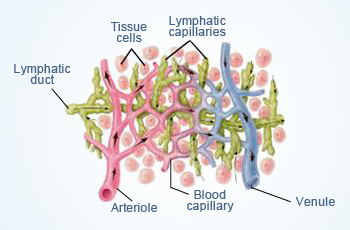 Lymphatic capillaries
The main purpose of these vessels is to drain excess tissue fluids from around the cell ready to be filtered and returned to the venous circulation. This tissue fluid upon entering the lumen (elongated cavity of a tubular structure) is known as the lymph.
Lymphatic capillaries
The main purpose of these vessels is to drain excess tissue fluids from around the cell ready to be filtered and returned to the venous circulation. This tissue fluid upon entering the lumen (elongated cavity of a tubular structure) is known as the lymph.
The lymphatic system is unique, in that it is a one–way system that returns lymph fluid via vessels to the cardiovascular system for eventual elimination of toxic byproducts by end organs, such as the kidney, liver, colon, skin and lungs.
The lymphatic system consists of the following parts:
- Lymph Capillaries
- Larger lymph vessels
- Lymph nodes/ Lymph glands
- Lymphoid organs/ Lymph
Lymph capillaries are tiny tubes which are present in the whole body (just like blood capillaries). Lymph capillaries, however, differ from blood capillaries in two ways: the end of the lymph capillaries in the tissues are closed, pores in the walls of lymph capillaries are bigger in size than that of the blood capillaries.
Lymph vessels: They collect the fluid and carry it from all of the body's tissues and then empty it into large veins in the upper chest, near the neck. The lymph capillaries join to form larger lymph vessels. Lymph vessels recycle the interstitial fluid and return it to the bloodstream in the circulatory system. The lymphatic capillaries coalesce to form larger mesh–like networks of tubes that are located deeper in the body; these are known as lymphatic vessels.
Lymph nodes: Lymph nodes are round or kidney–shaped. They are usually found in groups in different places throughout the body, including the neck, armpit, chest, abdomen, pelvis and groin.
 Primary and secondary lymphoid organs
The thymus and the bone marrow constitute the primary lymphoid tissues involved in the production and early selection of lymphocytes. The spleen filters blood in much the same way that lymph nodes filter lymph. Lymphocytes in the spleen react to pathogens in the blood and attempt to destroy them.
Primary and secondary lymphoid organs
The thymus and the bone marrow constitute the primary lymphoid tissues involved in the production and early selection of lymphocytes. The spleen filters blood in much the same way that lymph nodes filter lymph. Lymphocytes in the spleen react to pathogens in the blood and attempt to destroy them.
Primary lymphoid organs: The central or primary lymphoid organs generate lymphocytes from immature progenitor cells. The thymus and the bone marrow constitute the primary lymphoid tissues involved in the production and early selection of lymphocytes.
Secondary or peripheral lymphoid organs maintain mature naive lymphocytes and initiate an adaptive immune response. The peripheral lymphoid organs are the sites of lymphocyte activation by antigen. Activation leads to clonal expansion and affinity maturation. Mature lymphocytes recirculate between the blood and the peripheral lymphoid organs until they encounter their specific antigen.
Secondary lymphoid tissue provides the environment for the foreign or altered native molecules (antigens) to interact with the lymphocytes. It is exemplified by the lymph nodes, and the lymphoid follicles in tonsils, Peyer's patches, spleen, adenoids, skin, etc. that are associated with the mucosa–associated lymphoid tissue (MALT).